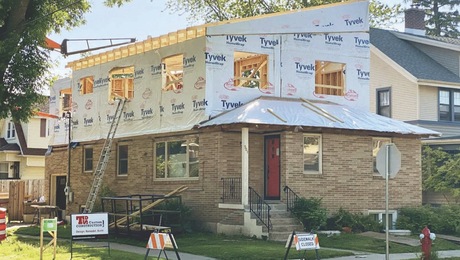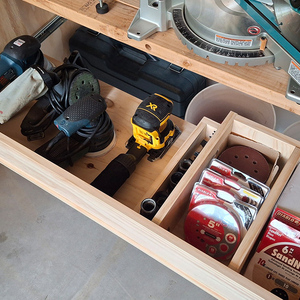I’m putting in a meter base tomorrow and because of the way it’s oriented the conductors to the house, some 300 feet away, is going to require two vertical 24″ sweeps and one horizontal 36″ sweep. The conduit is 3″ and the conductor is aluminum, sized for whatever the voltage drop is over 300 feet. Is this going to be a problem when it comes to pulling the wire? Specifically, is the horizontal sweep too much? I’m not sure if that much bend is allowed anyway and will check on that.
Thanks for any input from electricians out there.



















Replies
I should have proofread that post. The conduit from the meter base to the point of entry at the house is about 300 feet in length with the three bends.
It's hard to say without knowing how big your conductors are. That said, it's much less pulling friction to use two gentle 45 degree sweeps than one 90 degree sweep. Would that work for you?
I feel that it's slightly easier to pull thru conduit in cold weather than warm. Even though the wire is stiffer, the friction seems to be less.
I just did a pull yesterday in 2 1/2" conduit for a total change in direction of 180 degrees (only 60' though) and didn't even use pulling soap.
Edited 11/24/2008 12:06 pm ET by fingers
When the Hydro guys pulled my service conductor through our 300' duct they poured a few cups of cable lube into the duct and used a capstan winch to pull a rope which pulled the cable. It looked like it would have been a tough job to do by hand.
Scott.
Always remember those first immortal words that Adam said to Eve, “You’d better stand back, I don’t know how big this thing’s going to get.”
Florida Power and Light does not seem so constrained by the NEC (they use NESC anyway) and they build the pipe with the wire in it to some extent. They don't put the sweeps on until the wire is in the horizontal run.
my electrical buddies tell me that if you add all the degrees, they will only pull 360 degress total, if its more they have different pull ports.
you are correct. A pull-station is required should you exceed 360 degrees. "Soap" is what it is called, and you want plenty of it, wire-pulling lubricant is what it is. 300 feet is a long pull, you may consider tying the rope to a truck or skid-steer or something. Use a vacuum to suck a string tied to a small bag or something to get the string through the conduit. Gradually pull in bigger string until you have a string big enough to pull the rope that will be used to pull the conductors. Tape all of your conductors the right phase on both sides, and double check it, you don't want to be wrong on that one. Not really sure what your question was, but this is pretty much how we do it.
Some OSHA examples in the past of people getting killed pulling cables, due to the forces involved. Usuallly big cables on city streets or under city streets.
OSHA has been on-site during our wire pulls before. Just be sure you can tell them where the MSDS is located.
"...where the MSDS is located"
*chuckle*
Beer was created so carpenters wouldn't rule the world.
OSHA, that's a town in Wisconsin, isn't it?BruceT
So how did it go?
270 degrees total bends - should have been OK.
Jim
I just got back from finishing up the meter base install. The PG&E inspector gave the green light for putting in the pole and hooking up service. I found a meter base with a different knockout configuration so I'm figuring only two 90 degree sweeps. Going the 300 foot distance is next. Should be entertaining.
No one has mentioned this yet, but pulling big wires is not always the same as smaller ones. It's not uncommon to rig a pulley to allow additional force to help with the pull. Use pulling soap if you haven't done it before and don't let the wire pick up dirt before it goes into the conduit.
I'm sure there are limits to the amount of force allowed to pull a give size wire, but have no idea what those limits are.
Often electricians make somewhat arbitrary limits on what they'll pull based on the equipment and man power at their disposal, not on a structural or mechanical limit to the pull.
Good building!
Beer was created so carpenters wouldn't rule the world.
I'm attaching a pic of the situation. The 2" conduit leaving the meter base transitions to 3" as a 24" sweep just below top of concrete. The conduit will terminate at the house site just beyond the block wall in the distance, some 300' away. Hopefully the 2" section of conduit won't be a problem during the pull, (the customer side of the meterbase only had a 2" knockout as opposed to PG&E's side, which was 3"). I'll definitely be finding someone with a winch for pulling the wire. There was a fellow on this forum from norcal who owns a winch specifically for this purpose, if I can just locate his e-mail again.
Wouldn't it be easier with the meter base off for the pull?Scott.Always remember those first immortal words that Adam said to Eve, “You’d better stand back, I don’t know how big this thing’s going to get.”
I think PG&E will be hooking up their side of the meter base prior to my getting around to doing the trenching and pulling the wire to the house site. Otherwise, I think you're right. Seems to me it could be done with the box in place though.
Oh, I see. Somehow I thought the pull was on the utility side of the meter, not the house side. Now I see the issue.In my case the pull was on the utility side because we were pulling the 25KV primary to an on-site transformer in order to cut down on line loss.Are you concerned about line loss at 300'?Scott.Always remember those first immortal words that Adam said to Eve, “You’d better stand back, I don’t know how big this thing’s going to get.”
Apparently the voltage drop is manageble at 300', if the conductor is sized properly. I want to do a guest house that is 1400' or so beyond the main house though. That's going to require stepping up the voltage with a transformer and stepping down again at the termination. From what I understand there is a phenomenon known as "core loss" and a few other inefficiencies that will amount to around $50/month extra on the utility bill. Not looking forward to that.
sunsen,
http://www.power-save1200.com/1200.htmlThis device is supposed to somehow control the electricity loss in a home.Don't know if it fits your need, but seems to be well documented and the price not bad.Pete
Looks very interesting. I'm going to have to figure out exactly how this works but if it performs as advertised it would make a lot of sense to install, (for anyone, anywhere). I don't know whether the device would work on the transformers required to change the voltage for the trip up to the guest house. Technically, they're not part of the household electrical system. I sure like the idea of storing power lost to the core loss problem though. I'm going to have to look into this. Thanks.
It appears that core loss is inevitable. Certainly no outside device could affect it.http://www.tpub.com/content/doe/h1011v4/css/h1011v4_56.htmI'd guess that core loss could pretty quickly offset cost savings from using smaller wire gauge.BruceT
I guess the first thing that popped into my head reading about the power saving device was somehow being able to store the energy lost, not really stop it. That doesn't appear doable though. It would be interesting to know more about this stuff.
That Power-Save and other similar devices are basically a scam...they won't save you anything on your power bill. Theoretically they may slightly improve the power factor if you have a lot of motorized devices running in your house, but that doesn't affect metering on a residential service anyway.
Heh, heh, I just spoke to a fellow I do a lot of work for who's an electrical engineer about the power saving device and he said exactly the same thing. Actually, he says that it's the power company who pays for lost power as a result of motors and such by way of heat in the nuetral. That's why power companies started demanding 99 percent efficiency in computers, (my friend's field). I didn't fully understand his explanation but I do know he knows what he's talking about.
Also, he said be wary of any site on the internet offering "reseller opportunities", heh, heh!
Stuart,They sure seem to document residential success.
Of course they also are trying to get everyone into selling the product.I know or don't understand how it works, but like everyone else, am looking to save wherever possible.I try, unsuccessfully, to explain to my wife how she would quickly stop to pick up a dime on the sidewalk, but WON'T turn off anything. Like the 3 100 watt halogen bathroom light.Oh well live and learn.Pete
The Power-Save device is apparently a power factor correction capacitor (there may be other stuff inside the box, as they claim it's also a surge suppressor.) A properly sized power factor correction capacitor will help compensate for inductive motor loads, and gets your power factor closer to 1. However, residential utility meters don't take power factor into account, they just bill you for the amount of kilowatt-hours you've used. So, even if this thing does what they say it does, it won't save you any money on your power bill. Plus, if you were truely trying to correct the power factor, you'd need to switch in and out differing sizes of capacitors for each motor load as they turned on and off, where the Power-Save is just a single box with no active control.
Here's a FAQ from the Energy Star webpage about these things: http://energystar.custhelp.com/cgi-bin/energystar.cfg/php/enduser/std_adp.php?p_faqid=4941
"Power Factor Correction Devices claim to reduce residential energy bills and to prolong the productive life cycles of motors and appliances by reducing the reactive power (kVAR) that is needed from the electric utility.We have not seen any data that proves these types of products for residential use accomplish what they claim. Power factor correction devices improve power quality but do not generally improve energy efficiency (meaning they won't reduce your energy bill). There are several reasons why their energy efficiency claims could be exaggerated. First, residential customers are not charged for KVA-hour usage, but by kilowatt-hour usage. This means that any savings in energy demand will not directly result in lowering a residential user's utility bill. Second, the only potential for real power savings would occur if the product were only put in the circuit while a reactive load (such as a motor) were running, and taken out of the circuit when the motor is not running. This is impractical, given that there are several motors in a typical home that can come on at any time (refrigerator, air conditioner, HVAC blower, vacuum cleaner, etc.), but the unit itself is intended for permanent, unattended connection near the house breaker panel.
For commercial facilities, power factor correction will rarely be cost-effective based on energy savings alone. The bulk of cost savings power factor correction can offer is in the form of avoided utility charges for low power factor. Energy savings are usually below 1% and always below 3% of load, the higher percentage occurring where motors are a large fraction of the overall load of a facility. Energy savings alone do not make an installation cost effective."
Stuart,
Thanks for info.
I was getting serious about ordering the powersaver.They do have customer testimonials and even some exposure on TV, etc on conserving energy.Even if the advantage is mainly on electrical motors, I think the newer energy star refrigerators actually run more hours per day than older friges. One of our techs said they run about 80% of the time. Add to that furnace and AC motors and there would be more motor usage as you suggest.Getting close to retirement and we're doing all we can to lower costs.
Am wrapping rafters in heavy foil now to combat TX heat. Even in cooler weather the heat reduction is amazing under the foil vs open rafters.Pete
That thing is basically undocumented. I watched the video, and why didn't they show the electric meter when they turned the unit off and on? My guess is that it spins faster when the Power-Save is operating. It might be a good surge suppressor, might not.
Ok, glad you've got it figured. In our case (425 feet) it wouldn't work, so it cost about $7K to bring the primary and transformer onto the property. It was painful, but did it ever feel good to plug that first light in (after living with a generator for two years).Scott.Always remember those first immortal words that Adam said to Eve, “You’d better stand back, I don’t know how big this thing’s going to get.”
I bet that hurt. Having the power company pull primary line for you sure can get expensive. Here in norcal it's $35/ft and that's if you do the conduit, trenching, etc. That's $35/ft just to furnish and install the conductor. Adds up pretty quick.
>>>That's $35/ft just to furnish and install the conductor.Holy Smokes, that's steep. They're obviously not giving much consideration to the fact that you'll be a future customer.Always remember those first immortal words that Adam said to Eve, “You’d better stand back, I don’t know how big this thing’s going to get.”
Heh, heh, they couldn't possibly care less! PG&E does what's good for PG&E. They're pretty much the only game in town around here.